Strategic Procurement Issues: Toyota Australia Supply Chain Analysis
VerifiedAdded on 2020/05/01
|21
|5098
|102
Report
AI Summary
This report provides an executive summary, table of contents, and an introduction to the strategic procurement issues faced by Toyota Australia in its supply chain. It evaluates the company's supply strategy, identifying challenges stemming from the dynamic market environment and the departure of key suppliers like Holden. The report applies theories and models such as lean supply chain and Kraljic Portfolio Purchasing Model to analyze the issues. It explores the application of these models to Toyota's context, considering factors like supply risk and profit impact. The analysis leads to specific strategic recommendations aimed at resolving the identified supply chain challenges. The report emphasizes the need for Toyota to adapt to the Australian market's competitive landscape and build stronger relationships with suppliers to overcome its procurement issues.
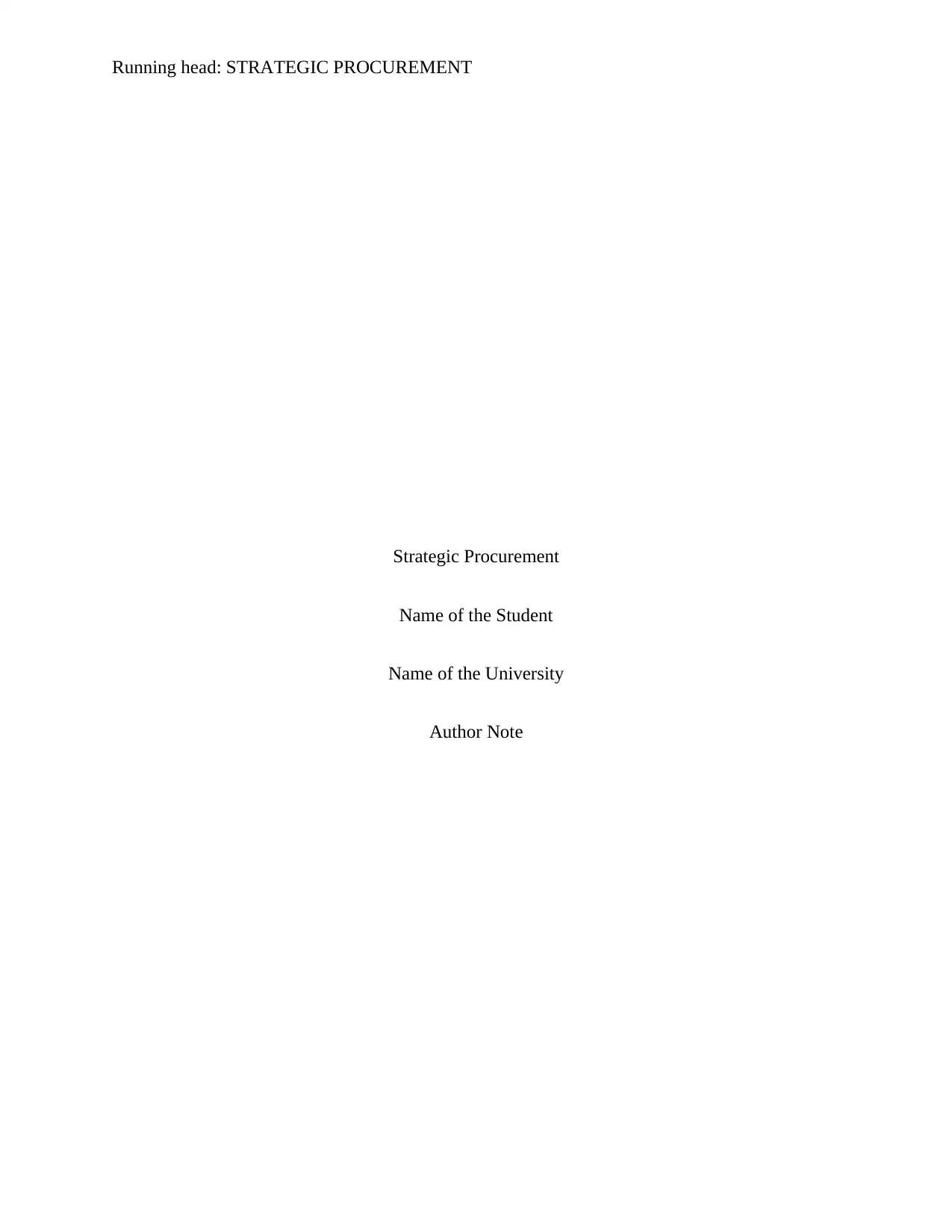
Running head: STRATEGIC PROCUREMENT
Strategic Procurement
Name of the Student
Name of the University
Author Note
Strategic Procurement
Name of the Student
Name of the University
Author Note
Paraphrase This Document
Need a fresh take? Get an instant paraphrase of this document with our AI Paraphraser
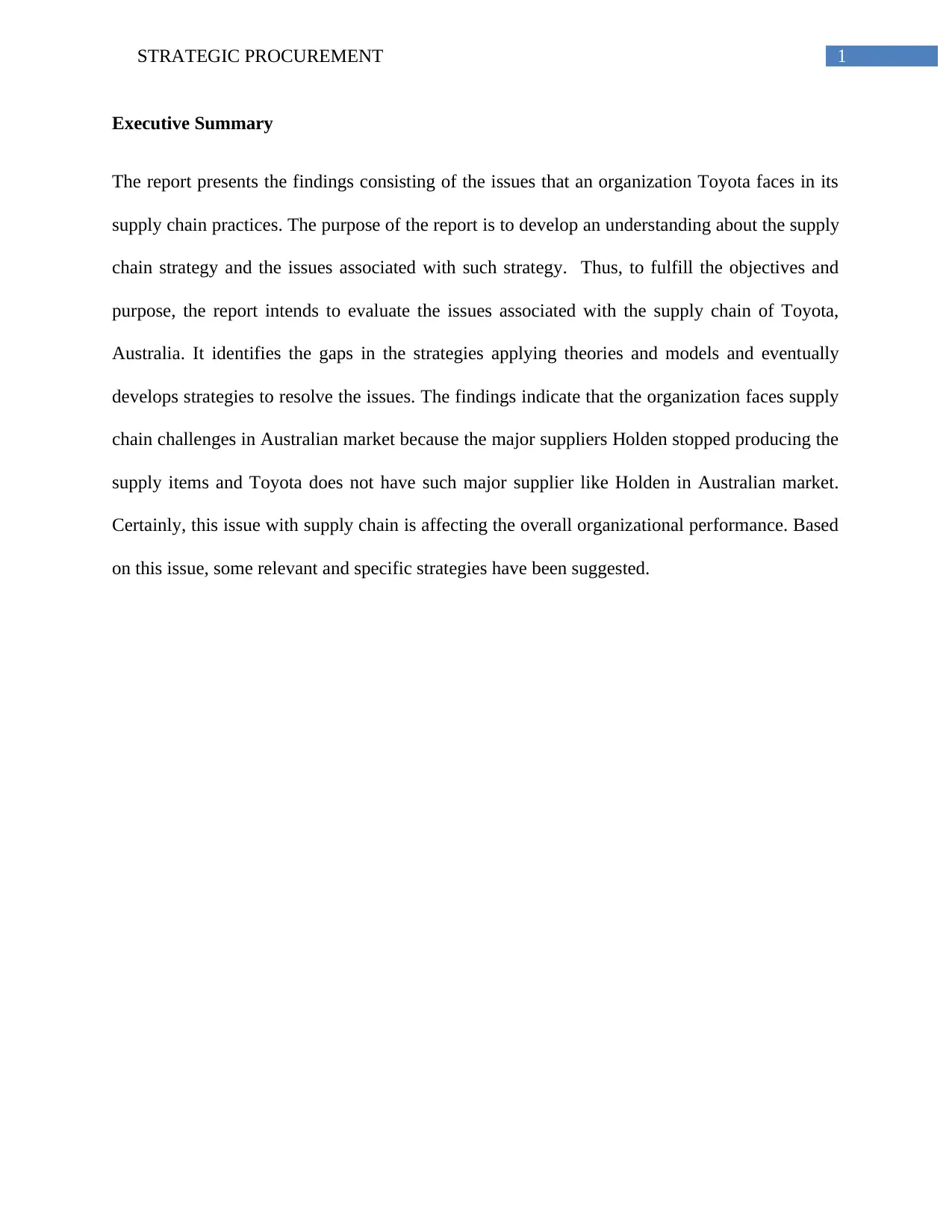
1STRATEGIC PROCUREMENT
Executive Summary
The report presents the findings consisting of the issues that an organization Toyota faces in its
supply chain practices. The purpose of the report is to develop an understanding about the supply
chain strategy and the issues associated with such strategy. Thus, to fulfill the objectives and
purpose, the report intends to evaluate the issues associated with the supply chain of Toyota,
Australia. It identifies the gaps in the strategies applying theories and models and eventually
develops strategies to resolve the issues. The findings indicate that the organization faces supply
chain challenges in Australian market because the major suppliers Holden stopped producing the
supply items and Toyota does not have such major supplier like Holden in Australian market.
Certainly, this issue with supply chain is affecting the overall organizational performance. Based
on this issue, some relevant and specific strategies have been suggested.
Executive Summary
The report presents the findings consisting of the issues that an organization Toyota faces in its
supply chain practices. The purpose of the report is to develop an understanding about the supply
chain strategy and the issues associated with such strategy. Thus, to fulfill the objectives and
purpose, the report intends to evaluate the issues associated with the supply chain of Toyota,
Australia. It identifies the gaps in the strategies applying theories and models and eventually
develops strategies to resolve the issues. The findings indicate that the organization faces supply
chain challenges in Australian market because the major suppliers Holden stopped producing the
supply items and Toyota does not have such major supplier like Holden in Australian market.
Certainly, this issue with supply chain is affecting the overall organizational performance. Based
on this issue, some relevant and specific strategies have been suggested.
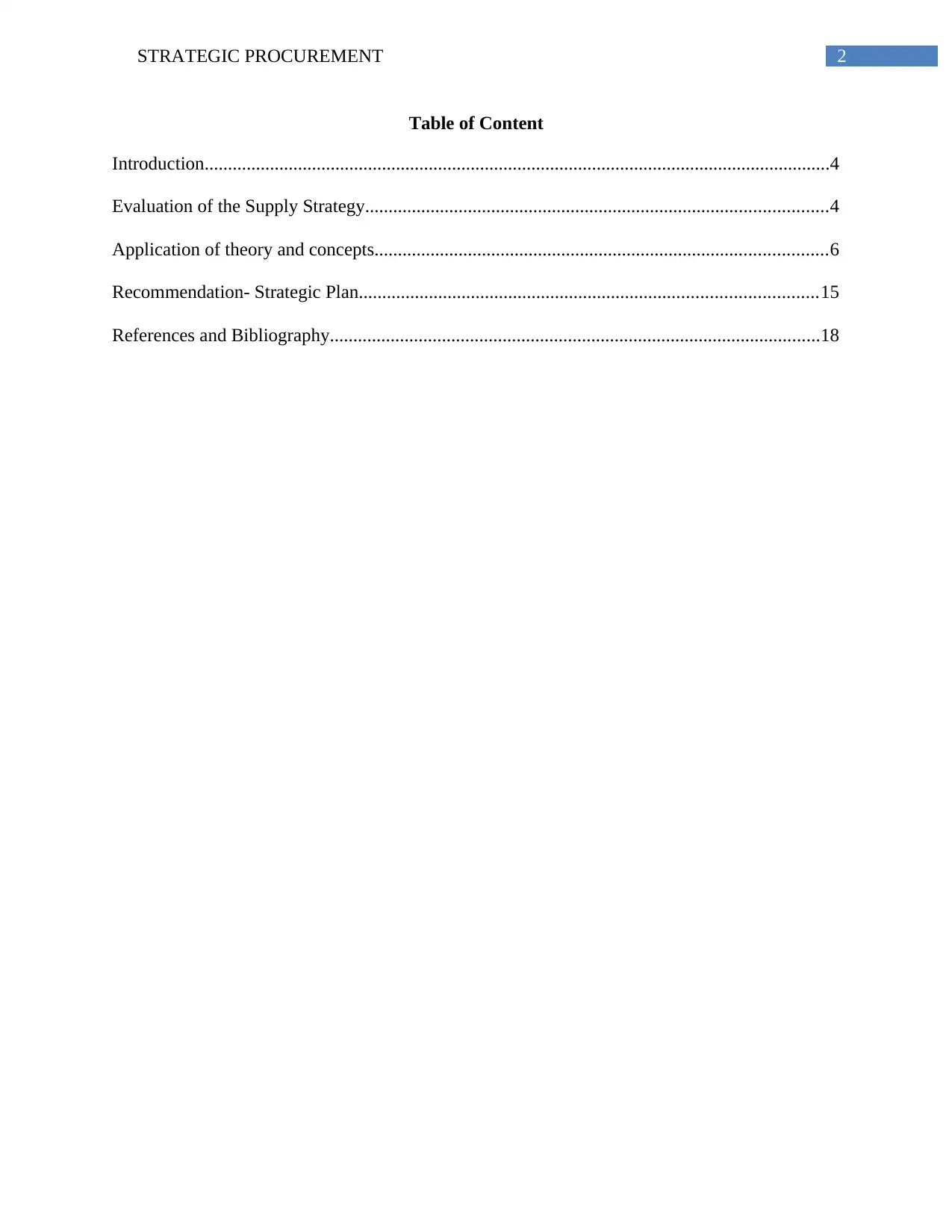
2STRATEGIC PROCUREMENT
Table of Content
Introduction......................................................................................................................................4
Evaluation of the Supply Strategy...................................................................................................4
Application of theory and concepts.................................................................................................6
Recommendation- Strategic Plan..................................................................................................15
References and Bibliography.........................................................................................................18
Table of Content
Introduction......................................................................................................................................4
Evaluation of the Supply Strategy...................................................................................................4
Application of theory and concepts.................................................................................................6
Recommendation- Strategic Plan..................................................................................................15
References and Bibliography.........................................................................................................18
⊘ This is a preview!⊘
Do you want full access?
Subscribe today to unlock all pages.

Trusted by 1+ million students worldwide
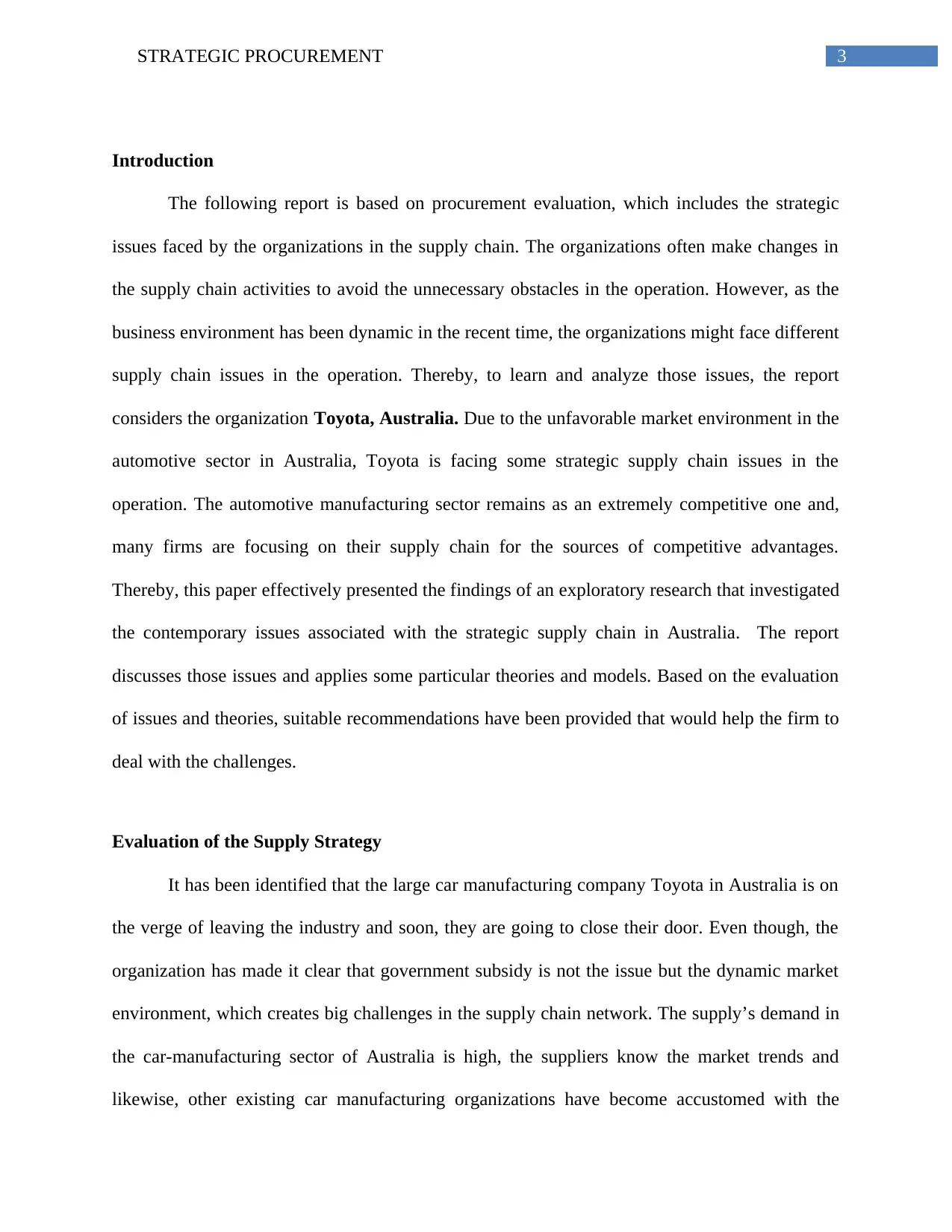
3STRATEGIC PROCUREMENT
Introduction
The following report is based on procurement evaluation, which includes the strategic
issues faced by the organizations in the supply chain. The organizations often make changes in
the supply chain activities to avoid the unnecessary obstacles in the operation. However, as the
business environment has been dynamic in the recent time, the organizations might face different
supply chain issues in the operation. Thereby, to learn and analyze those issues, the report
considers the organization Toyota, Australia. Due to the unfavorable market environment in the
automotive sector in Australia, Toyota is facing some strategic supply chain issues in the
operation. The automotive manufacturing sector remains as an extremely competitive one and,
many firms are focusing on their supply chain for the sources of competitive advantages.
Thereby, this paper effectively presented the findings of an exploratory research that investigated
the contemporary issues associated with the strategic supply chain in Australia. The report
discusses those issues and applies some particular theories and models. Based on the evaluation
of issues and theories, suitable recommendations have been provided that would help the firm to
deal with the challenges.
Evaluation of the Supply Strategy
It has been identified that the large car manufacturing company Toyota in Australia is on
the verge of leaving the industry and soon, they are going to close their door. Even though, the
organization has made it clear that government subsidy is not the issue but the dynamic market
environment, which creates big challenges in the supply chain network. The supply’s demand in
the car-manufacturing sector of Australia is high, the suppliers know the market trends and
likewise, other existing car manufacturing organizations have become accustomed with the
Introduction
The following report is based on procurement evaluation, which includes the strategic
issues faced by the organizations in the supply chain. The organizations often make changes in
the supply chain activities to avoid the unnecessary obstacles in the operation. However, as the
business environment has been dynamic in the recent time, the organizations might face different
supply chain issues in the operation. Thereby, to learn and analyze those issues, the report
considers the organization Toyota, Australia. Due to the unfavorable market environment in the
automotive sector in Australia, Toyota is facing some strategic supply chain issues in the
operation. The automotive manufacturing sector remains as an extremely competitive one and,
many firms are focusing on their supply chain for the sources of competitive advantages.
Thereby, this paper effectively presented the findings of an exploratory research that investigated
the contemporary issues associated with the strategic supply chain in Australia. The report
discusses those issues and applies some particular theories and models. Based on the evaluation
of issues and theories, suitable recommendations have been provided that would help the firm to
deal with the challenges.
Evaluation of the Supply Strategy
It has been identified that the large car manufacturing company Toyota in Australia is on
the verge of leaving the industry and soon, they are going to close their door. Even though, the
organization has made it clear that government subsidy is not the issue but the dynamic market
environment, which creates big challenges in the supply chain network. The supply’s demand in
the car-manufacturing sector of Australia is high, the suppliers know the market trends and
likewise, other existing car manufacturing organizations have become accustomed with the
Paraphrase This Document
Need a fresh take? Get an instant paraphrase of this document with our AI Paraphraser
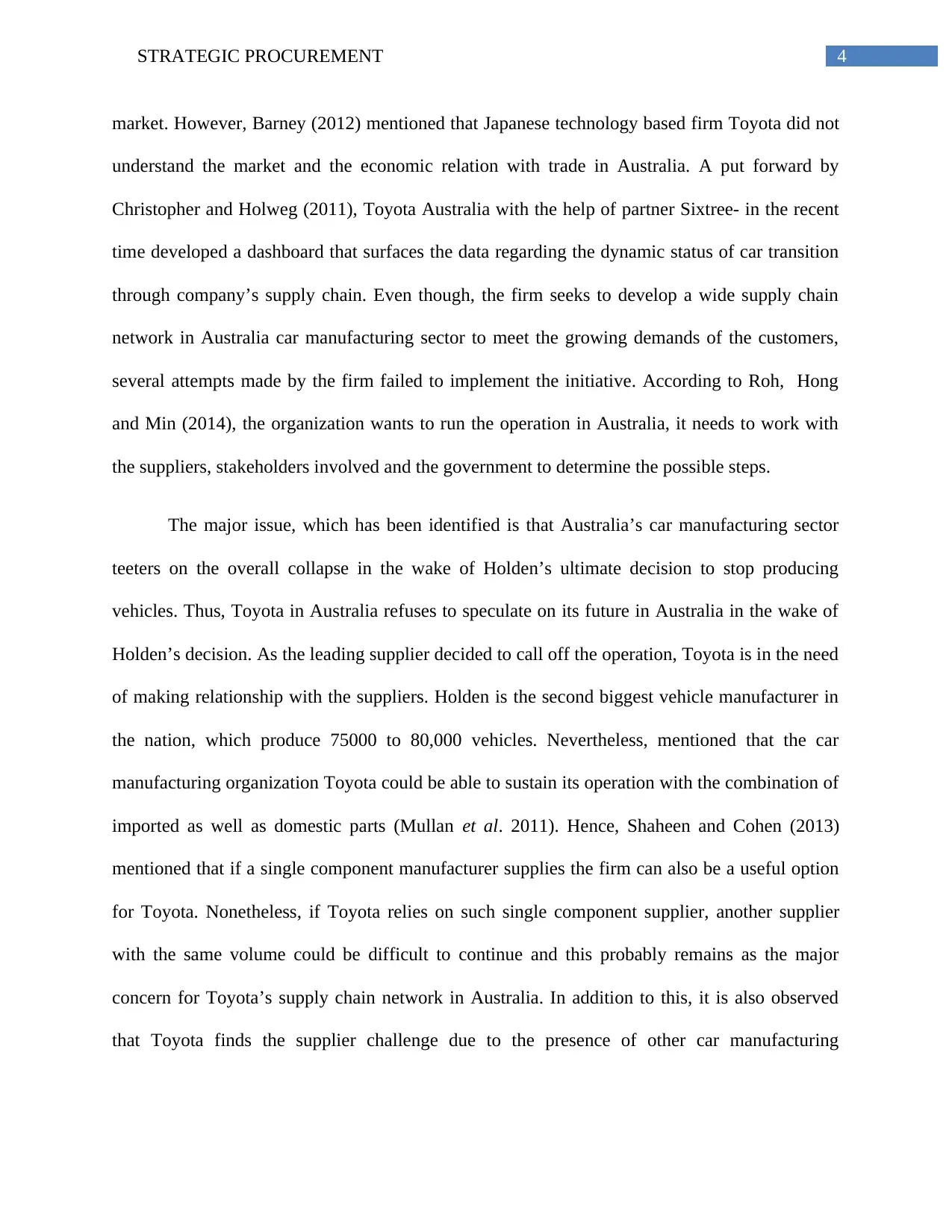
4STRATEGIC PROCUREMENT
market. However, Barney (2012) mentioned that Japanese technology based firm Toyota did not
understand the market and the economic relation with trade in Australia. A put forward by
Christopher and Holweg (2011), Toyota Australia with the help of partner Sixtree- in the recent
time developed a dashboard that surfaces the data regarding the dynamic status of car transition
through company’s supply chain. Even though, the firm seeks to develop a wide supply chain
network in Australia car manufacturing sector to meet the growing demands of the customers,
several attempts made by the firm failed to implement the initiative. According to Roh, Hong
and Min (2014), the organization wants to run the operation in Australia, it needs to work with
the suppliers, stakeholders involved and the government to determine the possible steps.
The major issue, which has been identified is that Australia’s car manufacturing sector
teeters on the overall collapse in the wake of Holden’s ultimate decision to stop producing
vehicles. Thus, Toyota in Australia refuses to speculate on its future in Australia in the wake of
Holden’s decision. As the leading supplier decided to call off the operation, Toyota is in the need
of making relationship with the suppliers. Holden is the second biggest vehicle manufacturer in
the nation, which produce 75000 to 80,000 vehicles. Nevertheless, mentioned that the car
manufacturing organization Toyota could be able to sustain its operation with the combination of
imported as well as domestic parts (Mullan et al. 2011). Hence, Shaheen and Cohen (2013)
mentioned that if a single component manufacturer supplies the firm can also be a useful option
for Toyota. Nonetheless, if Toyota relies on such single component supplier, another supplier
with the same volume could be difficult to continue and this probably remains as the major
concern for Toyota’s supply chain network in Australia. In addition to this, it is also observed
that Toyota finds the supplier challenge due to the presence of other car manufacturing
market. However, Barney (2012) mentioned that Japanese technology based firm Toyota did not
understand the market and the economic relation with trade in Australia. A put forward by
Christopher and Holweg (2011), Toyota Australia with the help of partner Sixtree- in the recent
time developed a dashboard that surfaces the data regarding the dynamic status of car transition
through company’s supply chain. Even though, the firm seeks to develop a wide supply chain
network in Australia car manufacturing sector to meet the growing demands of the customers,
several attempts made by the firm failed to implement the initiative. According to Roh, Hong
and Min (2014), the organization wants to run the operation in Australia, it needs to work with
the suppliers, stakeholders involved and the government to determine the possible steps.
The major issue, which has been identified is that Australia’s car manufacturing sector
teeters on the overall collapse in the wake of Holden’s ultimate decision to stop producing
vehicles. Thus, Toyota in Australia refuses to speculate on its future in Australia in the wake of
Holden’s decision. As the leading supplier decided to call off the operation, Toyota is in the need
of making relationship with the suppliers. Holden is the second biggest vehicle manufacturer in
the nation, which produce 75000 to 80,000 vehicles. Nevertheless, mentioned that the car
manufacturing organization Toyota could be able to sustain its operation with the combination of
imported as well as domestic parts (Mullan et al. 2011). Hence, Shaheen and Cohen (2013)
mentioned that if a single component manufacturer supplies the firm can also be a useful option
for Toyota. Nonetheless, if Toyota relies on such single component supplier, another supplier
with the same volume could be difficult to continue and this probably remains as the major
concern for Toyota’s supply chain network in Australia. In addition to this, it is also observed
that Toyota finds the supplier challenge due to the presence of other car manufacturing
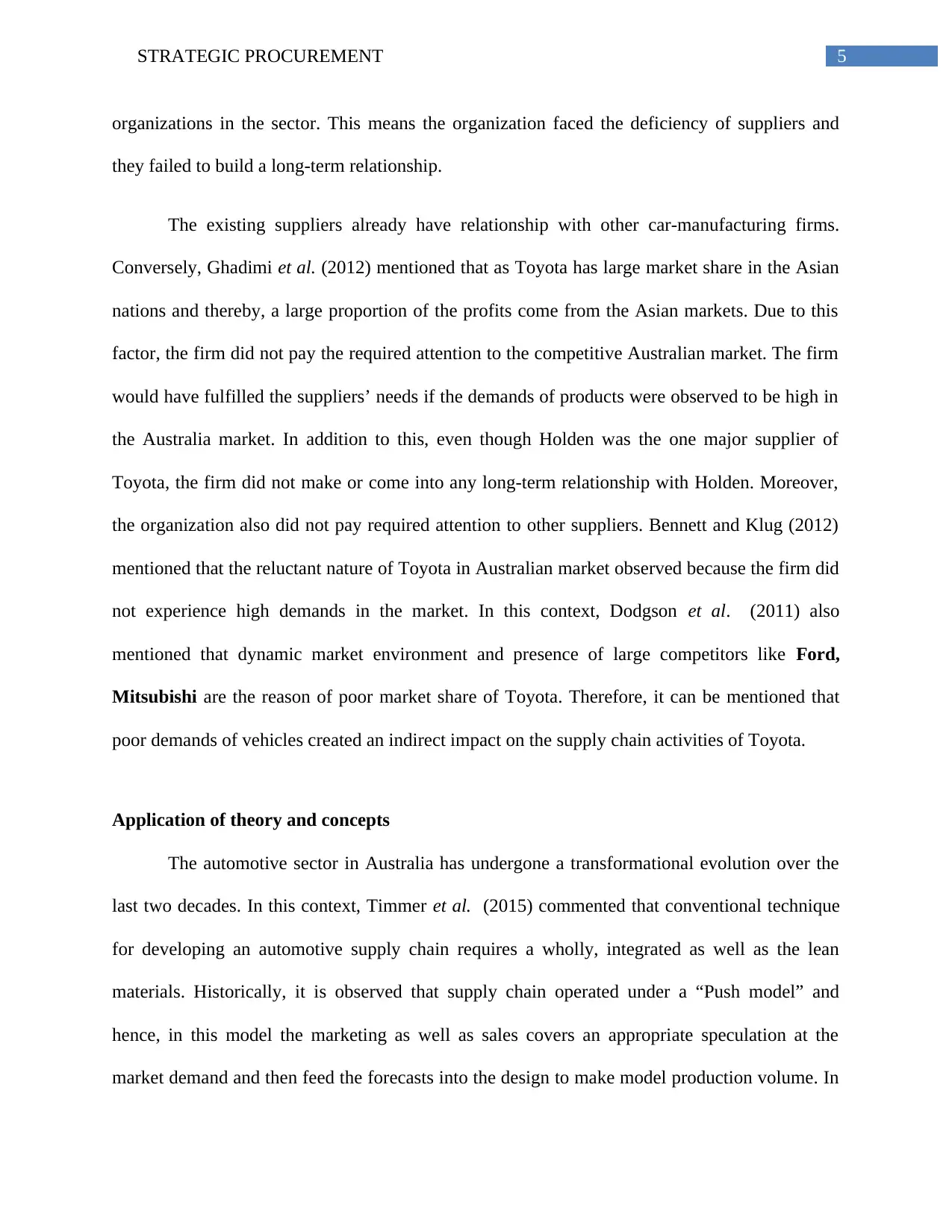
5STRATEGIC PROCUREMENT
organizations in the sector. This means the organization faced the deficiency of suppliers and
they failed to build a long-term relationship.
The existing suppliers already have relationship with other car-manufacturing firms.
Conversely, Ghadimi et al. (2012) mentioned that as Toyota has large market share in the Asian
nations and thereby, a large proportion of the profits come from the Asian markets. Due to this
factor, the firm did not pay the required attention to the competitive Australian market. The firm
would have fulfilled the suppliers’ needs if the demands of products were observed to be high in
the Australia market. In addition to this, even though Holden was the one major supplier of
Toyota, the firm did not make or come into any long-term relationship with Holden. Moreover,
the organization also did not pay required attention to other suppliers. Bennett and Klug (2012)
mentioned that the reluctant nature of Toyota in Australian market observed because the firm did
not experience high demands in the market. In this context, Dodgson et al. (2011) also
mentioned that dynamic market environment and presence of large competitors like Ford,
Mitsubishi are the reason of poor market share of Toyota. Therefore, it can be mentioned that
poor demands of vehicles created an indirect impact on the supply chain activities of Toyota.
Application of theory and concepts
The automotive sector in Australia has undergone a transformational evolution over the
last two decades. In this context, Timmer et al. (2015) commented that conventional technique
for developing an automotive supply chain requires a wholly, integrated as well as the lean
materials. Historically, it is observed that supply chain operated under a “Push model” and
hence, in this model the marketing as well as sales covers an appropriate speculation at the
market demand and then feed the forecasts into the design to make model production volume. In
organizations in the sector. This means the organization faced the deficiency of suppliers and
they failed to build a long-term relationship.
The existing suppliers already have relationship with other car-manufacturing firms.
Conversely, Ghadimi et al. (2012) mentioned that as Toyota has large market share in the Asian
nations and thereby, a large proportion of the profits come from the Asian markets. Due to this
factor, the firm did not pay the required attention to the competitive Australian market. The firm
would have fulfilled the suppliers’ needs if the demands of products were observed to be high in
the Australia market. In addition to this, even though Holden was the one major supplier of
Toyota, the firm did not make or come into any long-term relationship with Holden. Moreover,
the organization also did not pay required attention to other suppliers. Bennett and Klug (2012)
mentioned that the reluctant nature of Toyota in Australian market observed because the firm did
not experience high demands in the market. In this context, Dodgson et al. (2011) also
mentioned that dynamic market environment and presence of large competitors like Ford,
Mitsubishi are the reason of poor market share of Toyota. Therefore, it can be mentioned that
poor demands of vehicles created an indirect impact on the supply chain activities of Toyota.
Application of theory and concepts
The automotive sector in Australia has undergone a transformational evolution over the
last two decades. In this context, Timmer et al. (2015) commented that conventional technique
for developing an automotive supply chain requires a wholly, integrated as well as the lean
materials. Historically, it is observed that supply chain operated under a “Push model” and
hence, in this model the marketing as well as sales covers an appropriate speculation at the
market demand and then feed the forecasts into the design to make model production volume. In
⊘ This is a preview!⊘
Do you want full access?
Subscribe today to unlock all pages.

Trusted by 1+ million students worldwide
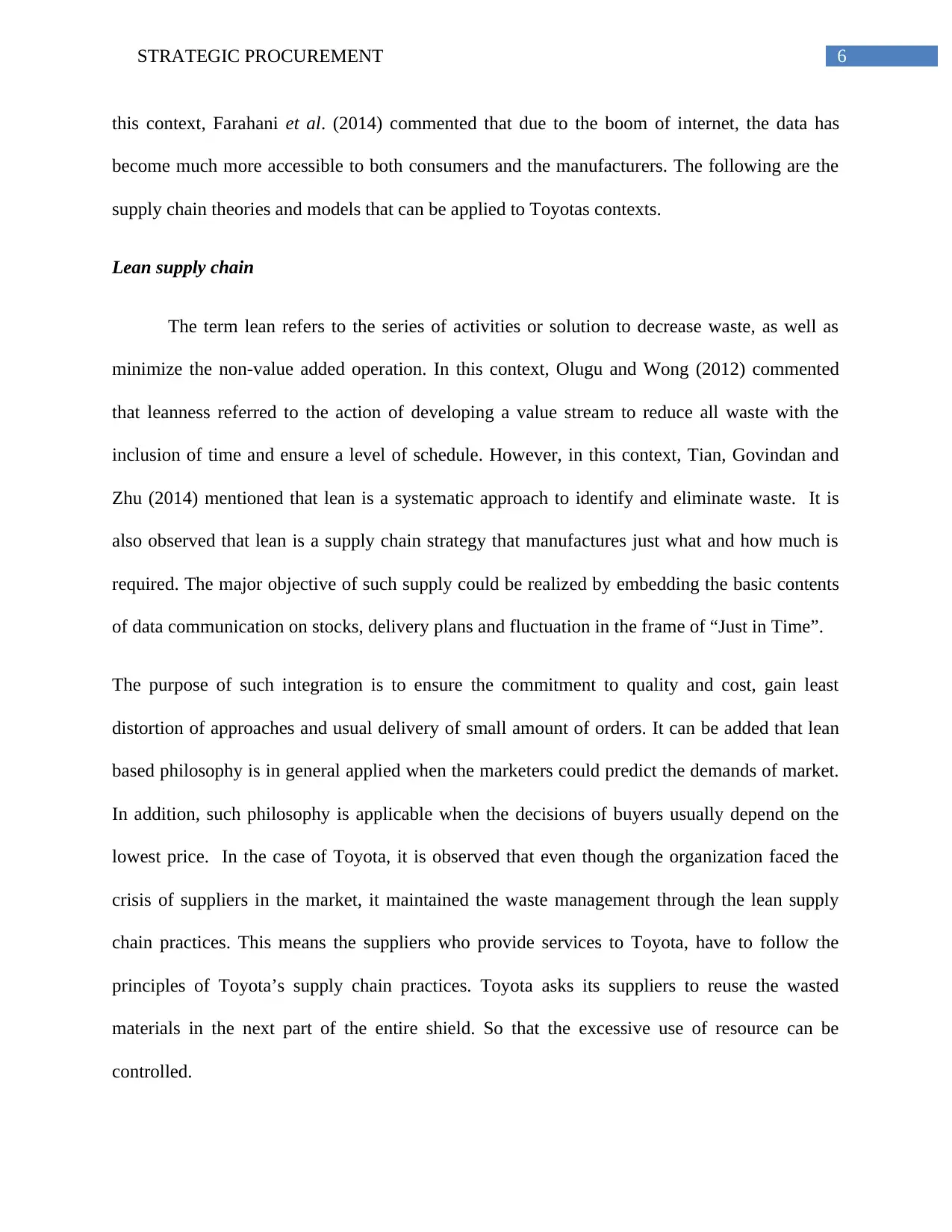
6STRATEGIC PROCUREMENT
this context, Farahani et al. (2014) commented that due to the boom of internet, the data has
become much more accessible to both consumers and the manufacturers. The following are the
supply chain theories and models that can be applied to Toyotas contexts.
Lean supply chain
The term lean refers to the series of activities or solution to decrease waste, as well as
minimize the non-value added operation. In this context, Olugu and Wong (2012) commented
that leanness referred to the action of developing a value stream to reduce all waste with the
inclusion of time and ensure a level of schedule. However, in this context, Tian, Govindan and
Zhu (2014) mentioned that lean is a systematic approach to identify and eliminate waste. It is
also observed that lean is a supply chain strategy that manufactures just what and how much is
required. The major objective of such supply could be realized by embedding the basic contents
of data communication on stocks, delivery plans and fluctuation in the frame of “Just in Time”.
The purpose of such integration is to ensure the commitment to quality and cost, gain least
distortion of approaches and usual delivery of small amount of orders. It can be added that lean
based philosophy is in general applied when the marketers could predict the demands of market.
In addition, such philosophy is applicable when the decisions of buyers usually depend on the
lowest price. In the case of Toyota, it is observed that even though the organization faced the
crisis of suppliers in the market, it maintained the waste management through the lean supply
chain practices. This means the suppliers who provide services to Toyota, have to follow the
principles of Toyota’s supply chain practices. Toyota asks its suppliers to reuse the wasted
materials in the next part of the entire shield. So that the excessive use of resource can be
controlled.
this context, Farahani et al. (2014) commented that due to the boom of internet, the data has
become much more accessible to both consumers and the manufacturers. The following are the
supply chain theories and models that can be applied to Toyotas contexts.
Lean supply chain
The term lean refers to the series of activities or solution to decrease waste, as well as
minimize the non-value added operation. In this context, Olugu and Wong (2012) commented
that leanness referred to the action of developing a value stream to reduce all waste with the
inclusion of time and ensure a level of schedule. However, in this context, Tian, Govindan and
Zhu (2014) mentioned that lean is a systematic approach to identify and eliminate waste. It is
also observed that lean is a supply chain strategy that manufactures just what and how much is
required. The major objective of such supply could be realized by embedding the basic contents
of data communication on stocks, delivery plans and fluctuation in the frame of “Just in Time”.
The purpose of such integration is to ensure the commitment to quality and cost, gain least
distortion of approaches and usual delivery of small amount of orders. It can be added that lean
based philosophy is in general applied when the marketers could predict the demands of market.
In addition, such philosophy is applicable when the decisions of buyers usually depend on the
lowest price. In the case of Toyota, it is observed that even though the organization faced the
crisis of suppliers in the market, it maintained the waste management through the lean supply
chain practices. This means the suppliers who provide services to Toyota, have to follow the
principles of Toyota’s supply chain practices. Toyota asks its suppliers to reuse the wasted
materials in the next part of the entire shield. So that the excessive use of resource can be
controlled.
Paraphrase This Document
Need a fresh take? Get an instant paraphrase of this document with our AI Paraphraser
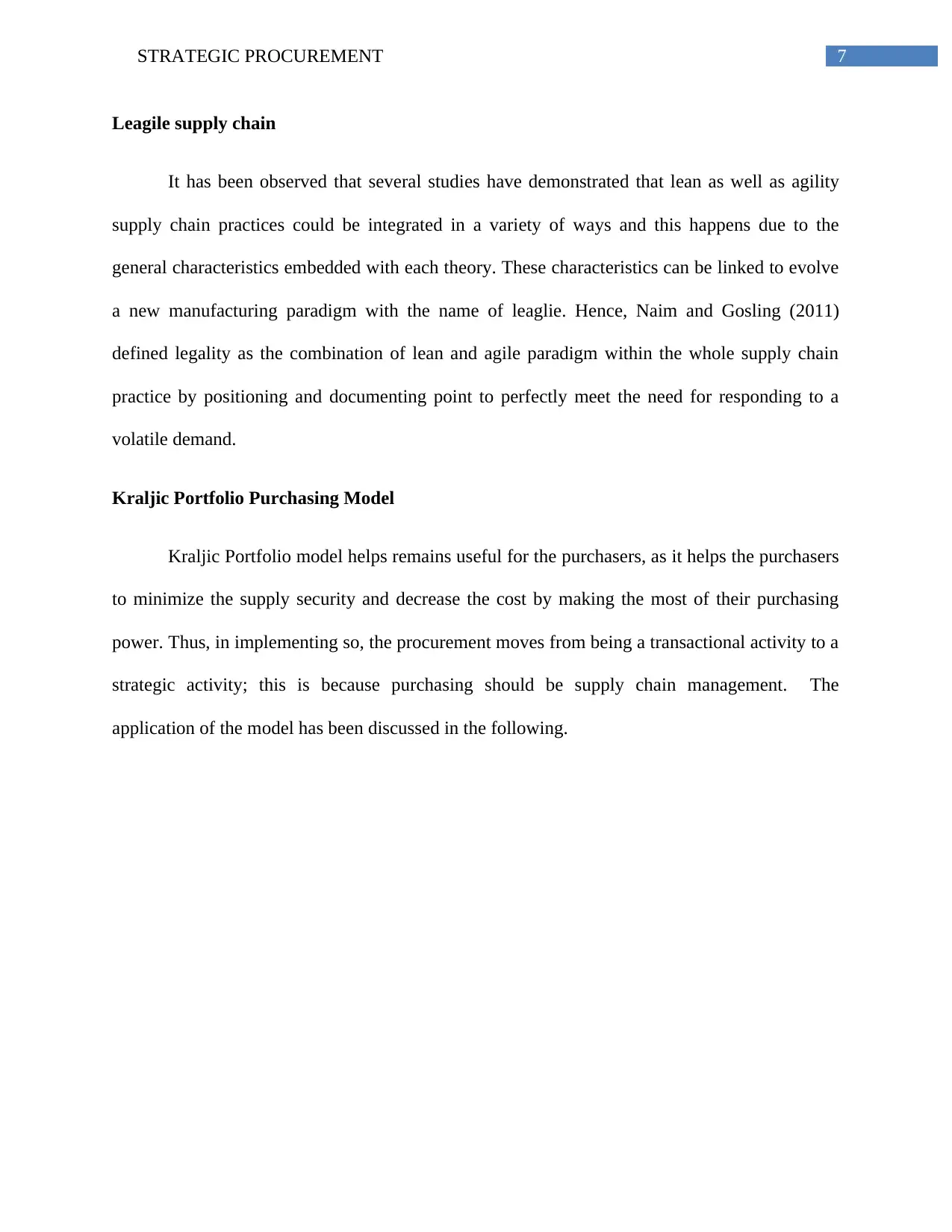
7STRATEGIC PROCUREMENT
Leagile supply chain
It has been observed that several studies have demonstrated that lean as well as agility
supply chain practices could be integrated in a variety of ways and this happens due to the
general characteristics embedded with each theory. These characteristics can be linked to evolve
a new manufacturing paradigm with the name of leaglie. Hence, Naim and Gosling (2011)
defined legality as the combination of lean and agile paradigm within the whole supply chain
practice by positioning and documenting point to perfectly meet the need for responding to a
volatile demand.
Kraljic Portfolio Purchasing Model
Kraljic Portfolio model helps remains useful for the purchasers, as it helps the purchasers
to minimize the supply security and decrease the cost by making the most of their purchasing
power. Thus, in implementing so, the procurement moves from being a transactional activity to a
strategic activity; this is because purchasing should be supply chain management. The
application of the model has been discussed in the following.
Leagile supply chain
It has been observed that several studies have demonstrated that lean as well as agility
supply chain practices could be integrated in a variety of ways and this happens due to the
general characteristics embedded with each theory. These characteristics can be linked to evolve
a new manufacturing paradigm with the name of leaglie. Hence, Naim and Gosling (2011)
defined legality as the combination of lean and agile paradigm within the whole supply chain
practice by positioning and documenting point to perfectly meet the need for responding to a
volatile demand.
Kraljic Portfolio Purchasing Model
Kraljic Portfolio model helps remains useful for the purchasers, as it helps the purchasers
to minimize the supply security and decrease the cost by making the most of their purchasing
power. Thus, in implementing so, the procurement moves from being a transactional activity to a
strategic activity; this is because purchasing should be supply chain management. The
application of the model has been discussed in the following.
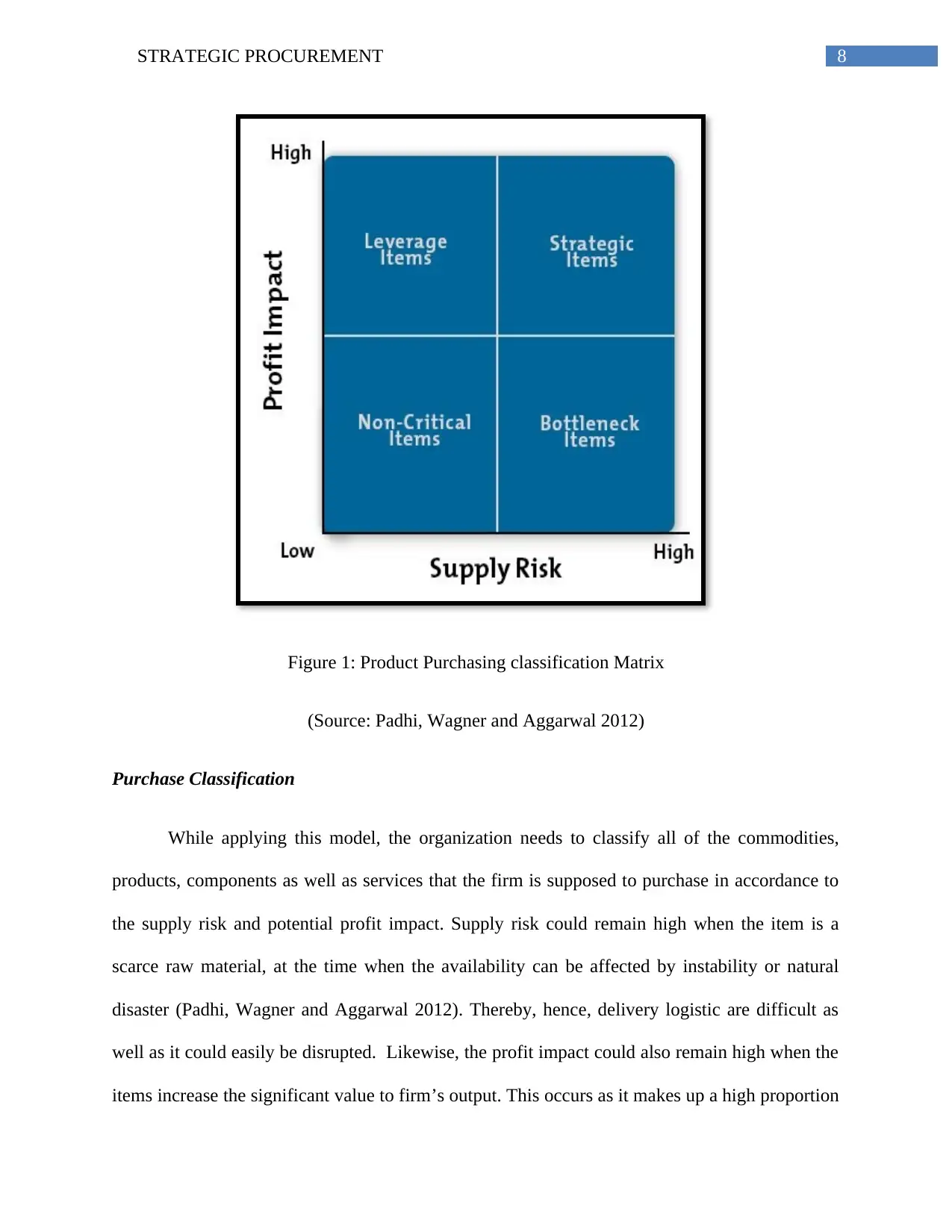
8STRATEGIC PROCUREMENT
Figure 1: Product Purchasing classification Matrix
(Source: Padhi, Wagner and Aggarwal 2012)
Purchase Classification
While applying this model, the organization needs to classify all of the commodities,
products, components as well as services that the firm is supposed to purchase in accordance to
the supply risk and potential profit impact. Supply risk could remain high when the item is a
scarce raw material, at the time when the availability can be affected by instability or natural
disaster (Padhi, Wagner and Aggarwal 2012). Thereby, hence, delivery logistic are difficult as
well as it could easily be disrupted. Likewise, the profit impact could also remain high when the
items increase the significant value to firm’s output. This occurs as it makes up a high proportion
Figure 1: Product Purchasing classification Matrix
(Source: Padhi, Wagner and Aggarwal 2012)
Purchase Classification
While applying this model, the organization needs to classify all of the commodities,
products, components as well as services that the firm is supposed to purchase in accordance to
the supply risk and potential profit impact. Supply risk could remain high when the item is a
scarce raw material, at the time when the availability can be affected by instability or natural
disaster (Padhi, Wagner and Aggarwal 2012). Thereby, hence, delivery logistic are difficult as
well as it could easily be disrupted. Likewise, the profit impact could also remain high when the
items increase the significant value to firm’s output. This occurs as it makes up a high proportion
⊘ This is a preview!⊘
Do you want full access?
Subscribe today to unlock all pages.

Trusted by 1+ million students worldwide
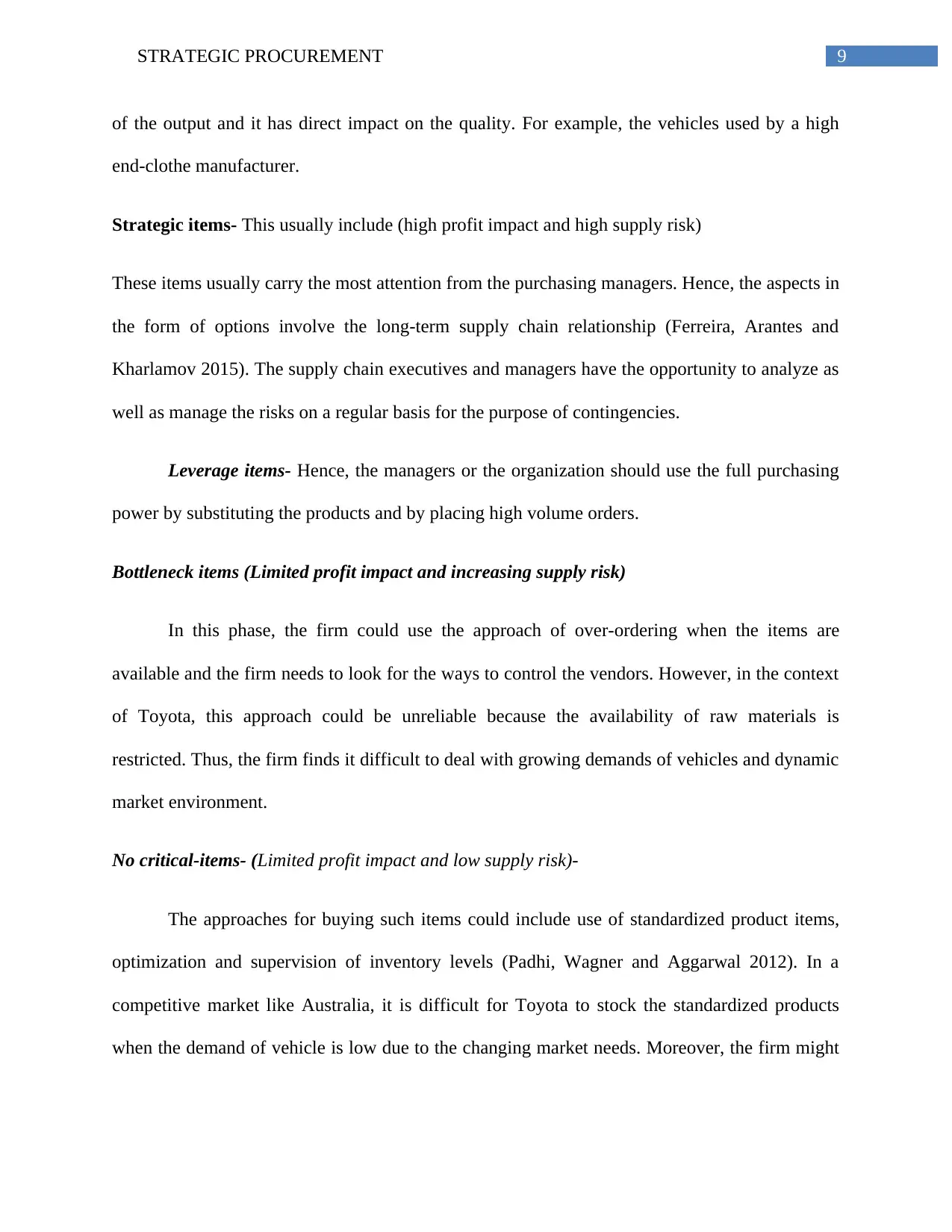
9STRATEGIC PROCUREMENT
of the output and it has direct impact on the quality. For example, the vehicles used by a high
end-clothe manufacturer.
Strategic items- This usually include (high profit impact and high supply risk)
These items usually carry the most attention from the purchasing managers. Hence, the aspects in
the form of options involve the long-term supply chain relationship (Ferreira, Arantes and
Kharlamov 2015). The supply chain executives and managers have the opportunity to analyze as
well as manage the risks on a regular basis for the purpose of contingencies.
Leverage items- Hence, the managers or the organization should use the full purchasing
power by substituting the products and by placing high volume orders.
Bottleneck items (Limited profit impact and increasing supply risk)
In this phase, the firm could use the approach of over-ordering when the items are
available and the firm needs to look for the ways to control the vendors. However, in the context
of Toyota, this approach could be unreliable because the availability of raw materials is
restricted. Thus, the firm finds it difficult to deal with growing demands of vehicles and dynamic
market environment.
No critical-items- (Limited profit impact and low supply risk)-
The approaches for buying such items could include use of standardized product items,
optimization and supervision of inventory levels (Padhi, Wagner and Aggarwal 2012). In a
competitive market like Australia, it is difficult for Toyota to stock the standardized products
when the demand of vehicle is low due to the changing market needs. Moreover, the firm might
of the output and it has direct impact on the quality. For example, the vehicles used by a high
end-clothe manufacturer.
Strategic items- This usually include (high profit impact and high supply risk)
These items usually carry the most attention from the purchasing managers. Hence, the aspects in
the form of options involve the long-term supply chain relationship (Ferreira, Arantes and
Kharlamov 2015). The supply chain executives and managers have the opportunity to analyze as
well as manage the risks on a regular basis for the purpose of contingencies.
Leverage items- Hence, the managers or the organization should use the full purchasing
power by substituting the products and by placing high volume orders.
Bottleneck items (Limited profit impact and increasing supply risk)
In this phase, the firm could use the approach of over-ordering when the items are
available and the firm needs to look for the ways to control the vendors. However, in the context
of Toyota, this approach could be unreliable because the availability of raw materials is
restricted. Thus, the firm finds it difficult to deal with growing demands of vehicles and dynamic
market environment.
No critical-items- (Limited profit impact and low supply risk)-
The approaches for buying such items could include use of standardized product items,
optimization and supervision of inventory levels (Padhi, Wagner and Aggarwal 2012). In a
competitive market like Australia, it is difficult for Toyota to stock the standardized products
when the demand of vehicle is low due to the changing market needs. Moreover, the firm might
Paraphrase This Document
Need a fresh take? Get an instant paraphrase of this document with our AI Paraphraser
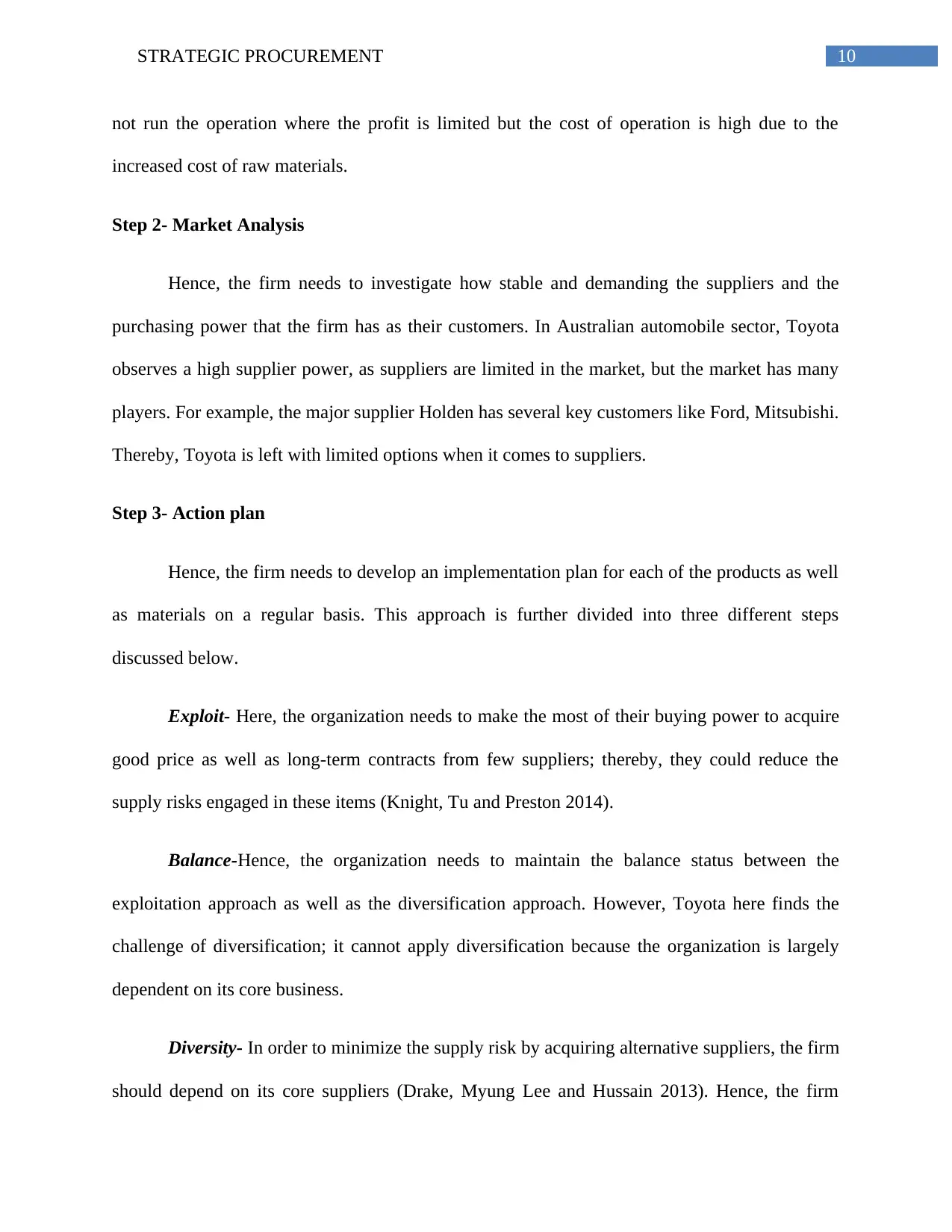
10STRATEGIC PROCUREMENT
not run the operation where the profit is limited but the cost of operation is high due to the
increased cost of raw materials.
Step 2- Market Analysis
Hence, the firm needs to investigate how stable and demanding the suppliers and the
purchasing power that the firm has as their customers. In Australian automobile sector, Toyota
observes a high supplier power, as suppliers are limited in the market, but the market has many
players. For example, the major supplier Holden has several key customers like Ford, Mitsubishi.
Thereby, Toyota is left with limited options when it comes to suppliers.
Step 3- Action plan
Hence, the firm needs to develop an implementation plan for each of the products as well
as materials on a regular basis. This approach is further divided into three different steps
discussed below.
Exploit- Here, the organization needs to make the most of their buying power to acquire
good price as well as long-term contracts from few suppliers; thereby, they could reduce the
supply risks engaged in these items (Knight, Tu and Preston 2014).
Balance-Hence, the organization needs to maintain the balance status between the
exploitation approach as well as the diversification approach. However, Toyota here finds the
challenge of diversification; it cannot apply diversification because the organization is largely
dependent on its core business.
Diversity- In order to minimize the supply risk by acquiring alternative suppliers, the firm
should depend on its core suppliers (Drake, Myung Lee and Hussain 2013). Hence, the firm
not run the operation where the profit is limited but the cost of operation is high due to the
increased cost of raw materials.
Step 2- Market Analysis
Hence, the firm needs to investigate how stable and demanding the suppliers and the
purchasing power that the firm has as their customers. In Australian automobile sector, Toyota
observes a high supplier power, as suppliers are limited in the market, but the market has many
players. For example, the major supplier Holden has several key customers like Ford, Mitsubishi.
Thereby, Toyota is left with limited options when it comes to suppliers.
Step 3- Action plan
Hence, the firm needs to develop an implementation plan for each of the products as well
as materials on a regular basis. This approach is further divided into three different steps
discussed below.
Exploit- Here, the organization needs to make the most of their buying power to acquire
good price as well as long-term contracts from few suppliers; thereby, they could reduce the
supply risks engaged in these items (Knight, Tu and Preston 2014).
Balance-Hence, the organization needs to maintain the balance status between the
exploitation approach as well as the diversification approach. However, Toyota here finds the
challenge of diversification; it cannot apply diversification because the organization is largely
dependent on its core business.
Diversity- In order to minimize the supply risk by acquiring alternative suppliers, the firm
should depend on its core suppliers (Drake, Myung Lee and Hussain 2013). Hence, the firm
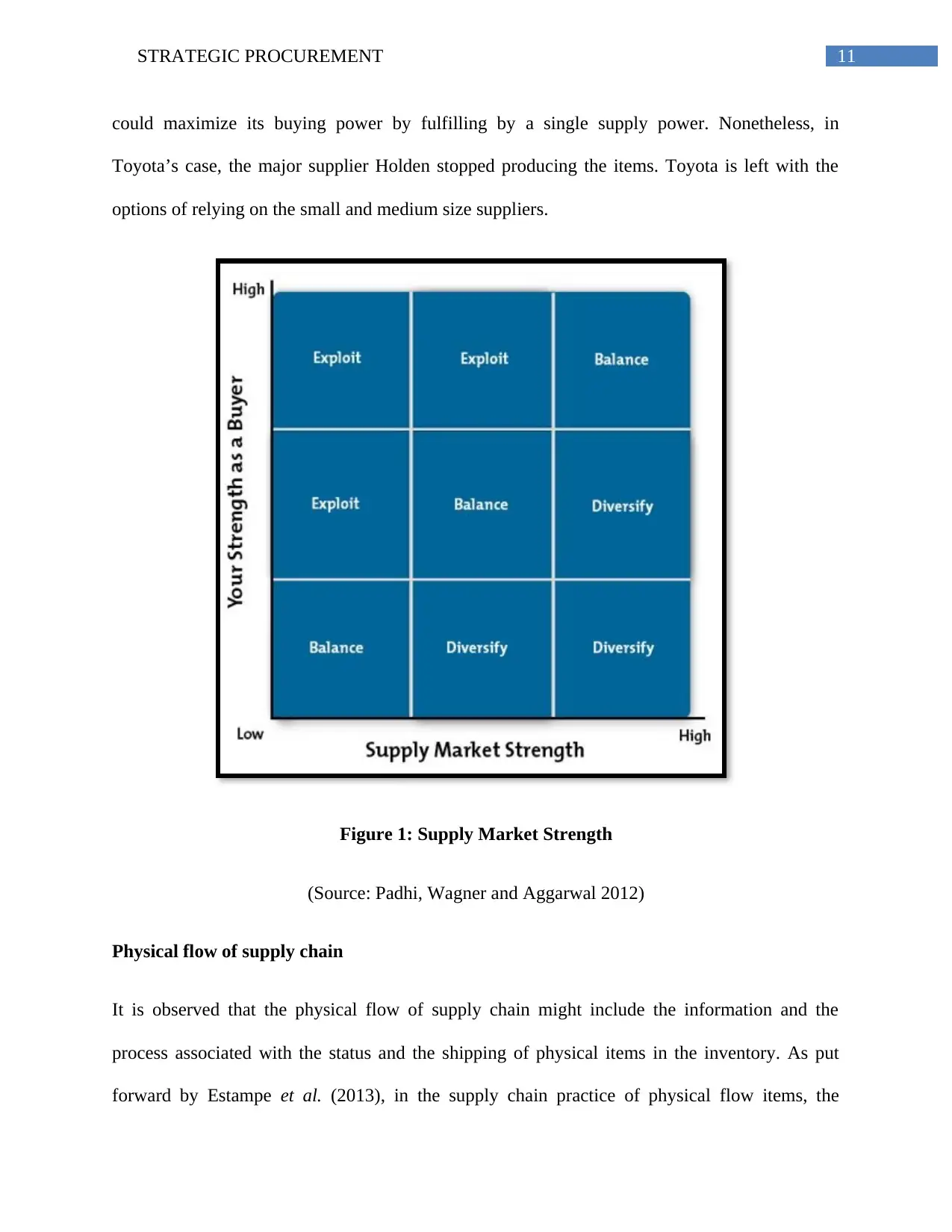
11STRATEGIC PROCUREMENT
could maximize its buying power by fulfilling by a single supply power. Nonetheless, in
Toyota’s case, the major supplier Holden stopped producing the items. Toyota is left with the
options of relying on the small and medium size suppliers.
Figure 1: Supply Market Strength
(Source: Padhi, Wagner and Aggarwal 2012)
Physical flow of supply chain
It is observed that the physical flow of supply chain might include the information and the
process associated with the status and the shipping of physical items in the inventory. As put
forward by Estampe et al. (2013), in the supply chain practice of physical flow items, the
could maximize its buying power by fulfilling by a single supply power. Nonetheless, in
Toyota’s case, the major supplier Holden stopped producing the items. Toyota is left with the
options of relying on the small and medium size suppliers.
Figure 1: Supply Market Strength
(Source: Padhi, Wagner and Aggarwal 2012)
Physical flow of supply chain
It is observed that the physical flow of supply chain might include the information and the
process associated with the status and the shipping of physical items in the inventory. As put
forward by Estampe et al. (2013), in the supply chain practice of physical flow items, the
⊘ This is a preview!⊘
Do you want full access?
Subscribe today to unlock all pages.

Trusted by 1+ million students worldwide
1 out of 21
Related Documents
Your All-in-One AI-Powered Toolkit for Academic Success.
+13062052269
info@desklib.com
Available 24*7 on WhatsApp / Email
![[object Object]](/_next/static/media/star-bottom.7253800d.svg)
Unlock your academic potential
Copyright © 2020–2025 A2Z Services. All Rights Reserved. Developed and managed by ZUCOL.





